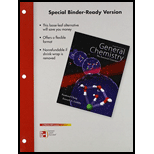
(a)
Interpretation:
The catalyst, intermediate, and the rate-determining step if the rate law is
Concept introduction:
Reaction: Substances which are mutually involved each other in a chemical process and changed into different substances.
Mechanism of a reaction: The representation of step by step process involved in the chemical process is said to be mechanism of a
Rate determining step of a reaction: The speed or rate at which the overall the total reaction done and which is slowest step of the chemical reaction.
Catalyst: A substance or a compound which promotes the rate of a chemical reaction is said to be catalyst.
Rate of a reaction: It represents the speed at which a chemical reaction runs. How much concentration of reactants consumed and how much concentration of product formed in a unit of time is said to be
To identify the catalyst, intermediate, and the rate-determining step if the rate law is
(b)
Interpretation:
The given reaction is slow without the catalyst has to be explained.
Concept introduction:
Reaction: Substances which are mutually involved each other in a chemical process and changed into different substances.
Mechanism of a reaction: The representation of step by step process involved in the chemical process is said to be mechanism of a chemical reaction.
Rate determining step of a reaction: The speed or rate at which the overall the total reaction done and which is slowest step of the chemical reaction.
Catalyst: A substance or a compound which promotes the rate of a chemical reaction is said to be catalyst.
Rate of a reaction: It represents the speed at which a chemical reaction runs. How much concentration of reactants consumed and how much concentration of product formed in a unit of time is said to be rate of reaction.
To explain the given reaction is slow without the catalyst
(c)
Interpretation:
The types of catalysis have to be explained.
Concept introduction:
Reaction: Substances which are mutually involved each other in a chemical process and changed into different substances.
Mechanism of a reaction: The representation of step by step process involved in the chemical process is said to be mechanism of a chemical reaction.
Rate determining step of a reaction: The speed or rate at which the overall the total reaction done and which is slowest step of the chemical reaction.
Catalyst: A substance or a compound which promotes the rate of a chemical reaction is said to be catalyst.
Rate of a reaction: It represents the speed at which a chemical reaction runs. How much concentration of reactants consumed and how much concentration of product formed in a unit of time is said to be rate of reaction.
To explain the types of catalysis
Want to see the full answer?
Check out a sample textbook solution
Chapter 14 Solutions
Loose Leaf For General Chemistry With Connect Access Card
 ChemistryChemistryISBN:9781305957404Author:Steven S. Zumdahl, Susan A. Zumdahl, Donald J. DeCostePublisher:Cengage Learning
ChemistryChemistryISBN:9781305957404Author:Steven S. Zumdahl, Susan A. Zumdahl, Donald J. DeCostePublisher:Cengage Learning ChemistryChemistryISBN:9781259911156Author:Raymond Chang Dr., Jason Overby ProfessorPublisher:McGraw-Hill Education
ChemistryChemistryISBN:9781259911156Author:Raymond Chang Dr., Jason Overby ProfessorPublisher:McGraw-Hill Education Principles of Instrumental AnalysisChemistryISBN:9781305577213Author:Douglas A. Skoog, F. James Holler, Stanley R. CrouchPublisher:Cengage Learning
Principles of Instrumental AnalysisChemistryISBN:9781305577213Author:Douglas A. Skoog, F. James Holler, Stanley R. CrouchPublisher:Cengage Learning Organic ChemistryChemistryISBN:9780078021558Author:Janice Gorzynski Smith Dr.Publisher:McGraw-Hill Education
Organic ChemistryChemistryISBN:9780078021558Author:Janice Gorzynski Smith Dr.Publisher:McGraw-Hill Education Chemistry: Principles and ReactionsChemistryISBN:9781305079373Author:William L. Masterton, Cecile N. HurleyPublisher:Cengage Learning
Chemistry: Principles and ReactionsChemistryISBN:9781305079373Author:William L. Masterton, Cecile N. HurleyPublisher:Cengage Learning Elementary Principles of Chemical Processes, Bind...ChemistryISBN:9781118431221Author:Richard M. Felder, Ronald W. Rousseau, Lisa G. BullardPublisher:WILEY
Elementary Principles of Chemical Processes, Bind...ChemistryISBN:9781118431221Author:Richard M. Felder, Ronald W. Rousseau, Lisa G. BullardPublisher:WILEY





